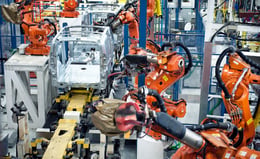5 Benefits of Supply Chain Integration
Brian Hoey - January 08, 2019

In baseball, the pitcher and the catcher must communicate via signs in order to implement a strategy to get the batter out. Depending on the strategy, the various fielders may need to position themselves closer to or farther away from home plate (if the pitcher is trying to induce a ground ball out or a fly ball out, for instance), which means that the strategy must be agreed upon beforehand and disseminated amongst the entire squad—not just the pitcher and the catcher. Picture the alternative: the pitcher decides on his own what approach to take, and the catcher is stuck trying to catch whatever is thrown at him without any advanced notice; meanwhile, the fielders don’t know what to expect, so they’re not able to position themselves appropriately. As a result, a batted ball is likely to result in chaos.
Believe it or not, the difference between a baseball team communicating about strategy or not is a lot like the difference between an integrated supply chain and a non-integrated supply chain. In a supply chain lacking integration, different teams within an organization have little to no insight into one another’s plans and strategies, meaning that disparate groups operate in silos, focusing only on what's in their own interests (even if it’s to the detriment of other operations). This hardly seems like an ideal way for a supply chain to function—suggesting that supply chain integration might have more than a few benefits to offer the savvy manufacturer.
1. E2E Visibility
Supply chain integration is the process of creating cohesion and increasing connectivity throughout the entire value chain, from procurement to production planning to logistics. Rather than letting each individual function exist in its own silo, supply chain integration brings these disparate functions together in such a way as to promote collaboration and decrease disconnect. This can be done through IT solutions that help to centralize cross-operational data or via other means, but regardless of how it’s achieved, the result should be a significant increase in cross-operational visibility. In an integrated environment, the left hand always knows what the right is doing, and can adjust accordingly. Not only do teams avoid working at cross-purposes, they gain new insights into their position within the entire supply chain.
2. Added Flexibility
We saw in the benefit above the ways in which integration might help to smooth out the day-to-day functioning of a modern supply chain, but what effect does it have on disruption management? Since integration is fundamentally a process of increasing the knowledge and resources available to each distinct organizational unit, it stands to reason that those newly accessible resources could be leveraged to mitigate crises. If, for instance, your production planners are experiencing a breakdown and may have trouble meeting demand, an integrated environment would effectively position them to work with inventory managers to develop a strategy that saves value and maintains existing shipments. In the meantime, the production workflow might be rejiggered to produce only parts that don’t require the machine that’s down, so that they can make up the difference without too much lost time. This ability to change plans to suit new realities is often simply unavailable in more siloized environments. Or, to go back to our baseball analogy, integration helps make sure that everyone knows the signs, so that they can communicate new information and adapt their strategies on the fly.
3. Reduced Waste
Another benefit of keeping your various teams working together, rather than at cross purposes, is that waste is, on the whole, reduced. Why might be this be the case? Because teams are no longer redoubling one another’s efforts or implementing redundant processes. In a non-integrated environment, for instance, two teams might each have their own dedicated LTL (less-than-full truck load) shipments scheduled on a recurring basis. Sending two LTLs instead of potentially just one FTL (full truck load) is, of course, wasteful—and also incredibly easy to avoid in an integrated environment that gives each team insight into the other. Different teams within an integrated supply chain should be able to work together to bundle shipments, find new efficiencies, and generally uncover areas of waste and redundancy.
4. Data Centralization
Speaking of uncovering areas of waste and redundancy. We spoke a little bit above about the increased data visibility that an integrated environment affords, much of which can come in the form of creating a centralized cache of highly accessible information. While data centralization is certainly a good thing in its own right, it also, crucially, helps to pave the way for advanced analytics workflows that can—you guessed it—help you uncover areas of inefficiency within your existing operations. By training advanced predictive and prescriptive algorithms on a centralized data repository, you can not only gain prescriptive insights into how to improve the overall efficiency of your value chain, you can also improve your forecast quality and run simulations on digital versions of your supply chain to determine the best possible responses to future events or disruptions.
5. Improved Margins
We’ve danced around this point, but it’s time to come right out and say it: each of the benefits we’ve outlined above can and should have a measurable positive impact on profit margins. Increases in efficiency (whether via increased collaboration or analytics-based insights) can help save money through reduced warehouse space and generally lean supply chain management; flexibility and improved disruption management can help you maintain value in the face of the unexpected, meaning fewer late shipments, shortages, or overages—any of which could prove extremely costly in the short or long term. By dynamically decreasing your costs in this way, supply chain integration can pave the way for more profitable operations. Sounds like a home run to us.
If you want to learn more get your Guide to Industry 4.0:
LATEST POSTS
- Understand Circular Economy in The Manufacturing Industry
- How Can Industry 4.0 IT Integration Be Achieved Smoothly?
- The Significance of Order Sequencing in Discrete Manufacturing
- How to improve your Supply Chain Management: The Power of Control Towers
- Optimizing Human Resource Scheduling in Manufacturing: A Technological Approach



